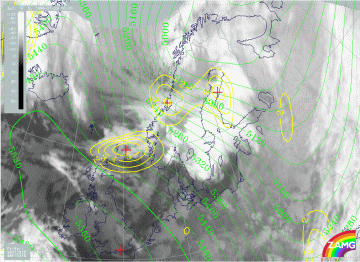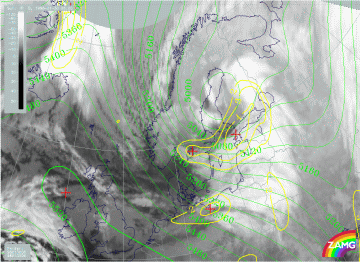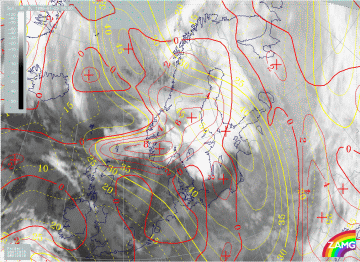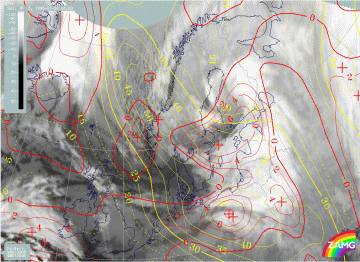PVA and jet streak diagnosis
|
29 January 1998/18.00 UTC - Meteosat IR image; green: height contours 500 hPa, yellow: positive vorticity advection (PVA) 500 hPa
|
30 January 1998/00.00 UTC - Meteosat IR image; green: height contours 500 hPa, yellow: positive vorticity advection (PVA) 500 hPa
|
|
30 January 1998/06.00 UTC - Meteosat IR image; green: height contours 500 hPa, yellow: positive vorticity advection (PVA) 500 hPa
|
|
Some interesting features can be seen in PVA at 500 hPa. At 18.00 UTC on 29 January (left image top) two distinct PVA maxima can be found; the western one centred at 64N/10E is associated with the upper trough, while the eastern one over the Quark (61N/21E) is, according to its history, connected with the Wave but without any pronounced upper level trough. The third maxima (which is actually the most intensive, though not within the scope of this study) on the coast of south-west Norway is associated with the former Upper level Low, in front of an upper level trough.
By 00.00 UTC on 30 January (right image top) all three PVA maxima are distinct. The PVA maximum associated with the occluding system over Finland has increased due to the formation of the Upper level Low over the Bay of Bothnia. Therefore curvature vorticity is a driving factor. The PVA maximum over Norway (63N/10E) is also connected with an upper level trough and superimposed on the cold frontal band.
The double structure of PVA at 500 hPa holds until 06.00 UTC on 30 January (left image bottom), though the individual PVA maxima are merging.
|
29 January 1998/18.00 UTC - Meteosat IR image; yellow: isotachs 300 hPa, red: positive vorticity advection (PVA) 300 hPa
|
30 January 1998/06.00 UTC - Meteosat IR image; yellow: isotachs 300 hPa, red: positive vorticity advection (PVA) 300 hPa
|
The isotachs at 300 hPa show that, in addition to the already-mentioned jet streak passing from north-west through central parts of Scandinavia towards the Baltic States, there is another jet streak quickly making its way from east of Greenland towards the Norwegian Sea. This jet streak is associated with the upper level trough over northern parts of Scandinavia and it moves - as can be seen - quite fast during these 12 hours towards south Scandinavia.
The associated PVA field on 29 January at 18.00 UTC (left image) shows a complex situation with an unclassical pattern of PVA and jet streaks. The inspection of shear and curvature vorticity patterns (not shown) indicates that the reason for this untypical PVA field is the intensive curvature of the upper level trough.
On 30 January at 06.00 UTC (right image) the original jet streak, which had existed from the very beginning and which was not well located and structured in the ECMWF analysis is now decaying; the remnants of it can be noticed over the Baltic Sea and the Baltic States. The jet streak rushing from the Norwegian Sea towards south Scandinavia has strengthened, and an associated PVA maximum can be found in the classical position - on the left exit area of the jet streak.




